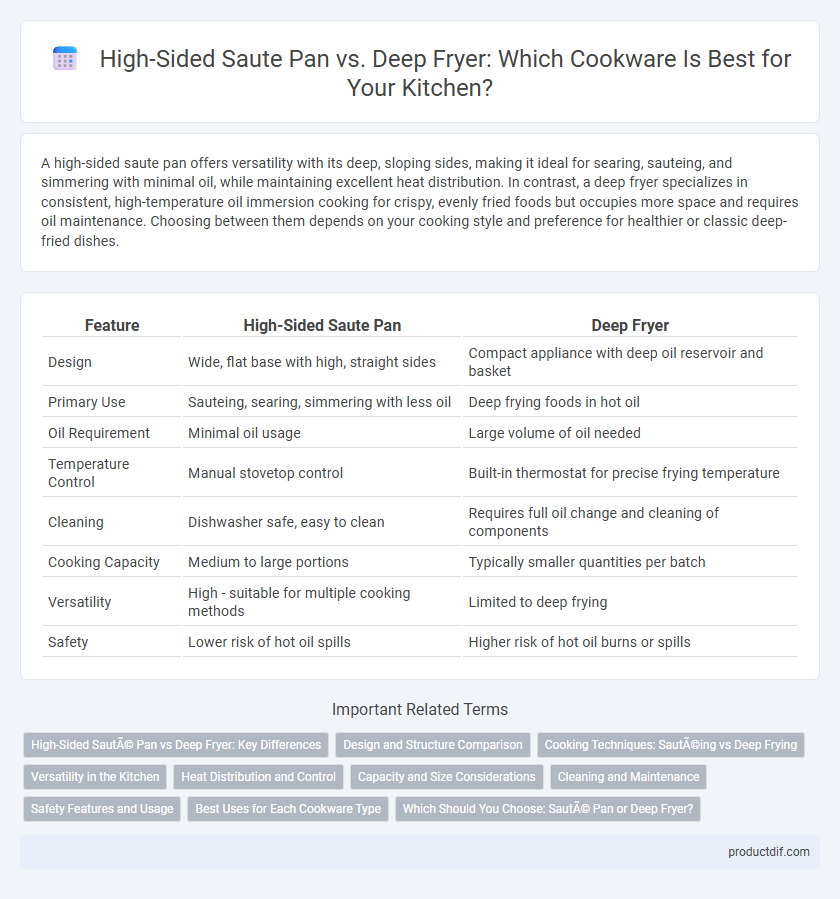A high-sided saute pan offers versatility with its deep, sloping sides, making it ideal for searing, sauteing, and simmering with minimal oil, while maintaining excellent heat distribution. In contrast, a deep fryer specializes in consistent, high-temperature oil immersion cooking for crispy, evenly fried foods but occupies more space and requires oil maintenance. Choosing between them depends on your cooking style and preference for healthier or classic deep-fried dishes.
Table of Comparison
| Feature | High-Sided Saute Pan | Deep Fryer |
|---|---|---|
| Design | Wide, flat base with high, straight sides | Compact appliance with deep oil reservoir and basket |
| Primary Use | Sauteing, searing, simmering with less oil | Deep frying foods in hot oil |
| Oil Requirement | Minimal oil usage | Large volume of oil needed |
| Temperature Control | Manual stovetop control | Built-in thermostat for precise frying temperature |
| Cleaning | Dishwasher safe, easy to clean | Requires full oil change and cleaning of components |
| Cooking Capacity | Medium to large portions | Typically smaller quantities per batch |
| Versatility | High - suitable for multiple cooking methods | Limited to deep frying |
| Safety | Lower risk of hot oil spills | Higher risk of hot oil burns or spills |
High-Sided Sauté Pan vs Deep Fryer: Key Differences
High-sided saute pans feature tall, straight sides ideal for searing, browning, and reducing sauces, offering versatility for various cooking techniques without excessive oil. Deep fryers maintain consistent oil temperature with built-in thermostats, providing precise frying for crispy, evenly cooked foods. Unlike deep fryers, saute pans require manual temperature control, making them better suited for multi-purpose cooking rather than dedicated deep frying.
Design and Structure Comparison
A high-sided saute pan features tall, straight sides and a wide, flat base designed for versatile cooking techniques including searing and reducing sauces. In contrast, a deep fryer is engineered with a large, deep basin and a heating element or burner tailored specifically for submerging food in hot oil, ensuring even frying. The saute pan's structure supports sauteing and simmering, while the deep fryer's design prioritizes oil capacity and temperature control for optimal frying results.
Cooking Techniques: Sautéing vs Deep Frying
High-sided saute pans offer excellent control for sauteing by allowing food to be tossed and stirred with minimal splatter while retaining moisture and flavor. Deep fryers provide consistent temperature control and submerge food completely in hot oil, ensuring even, crispy coatings ideal for deep frying techniques. Choosing between the two depends on the desired cooking method: searing and quick cooking with a saute pan or the intense, oil-based cooking process of a deep fryer.
Versatility in the Kitchen
High-sided saute pans offer exceptional versatility by allowing searing, sauteing, and simmering with their sloped sides and generous capacity, making them ideal for a range of cooking techniques. Deep fryers specialize in maintaining consistent oil temperature for frying tasks but lack the multi-functionality of saute pans. Investing in a high-sided saute pan enhances kitchen efficiency by supporting diverse recipes beyond frying, including sauces and reductions.
Heat Distribution and Control
High-sided saute pans offer superior heat distribution due to their thick, usually multi-layered bases that ensure even cooking across the surface, minimizing hot spots. Deep fryers provide precise temperature control with built-in thermostats, maintaining consistent heat ideal for frying at exact temperatures. While saute pans excel in versatility and even heat spreading, deep fryers specialize in maintaining stable, controllable oil temperatures for optimal frying results.
Capacity and Size Considerations
High-sided saute pans typically offer versatile capacity ranging from 3 to 5 quarts, suitable for sauteing, searing, and shallow frying with ample space for stirring ingredients. Deep fryers generally provide larger capacity options, from 1.5 to 6 liters or more, designed specifically for submerging food in oil for consistent deep frying results. Considering kitchen space, saute pans are more compact and easier to store, while deep fryers require additional counter space and ventilation due to their size and heat output.
Cleaning and Maintenance
High-sided saute pans offer easier cleaning due to their smooth surfaces and fewer components compared to deep fryers, which contain multiple removable parts and oil filters that require thorough scrubbing. Deep fryers often necessitate regular oil changes and meticulous cleaning to prevent residue buildup and maintain performance. Choosing a high-sided saute pan can save time on maintenance while still providing versatile cooking options.
Safety Features and Usage
High-sided saute pans offer enhanced safety features such as sturdy handles and deep rims that minimize oil splatters, making them ideal for controlled frying and sauteing with less risk of burns. Deep fryers are equipped with temperature controls and built-in lids that prevent oil overheating and reduce fire hazards, ensuring safer deep frying. Both appliances require careful handling, but saute pans provide greater versatility while deep fryers emphasize precise temperature management for safety during prolonged frying sessions.
Best Uses for Each Cookware Type
High-sided saute pans excel at searing, browning, and reducing sauces due to their wide surface area and tall sides, making them ideal for sauteing vegetables, simmering stews, and pan-frying meats. Deep fryers maintain consistent oil temperatures and provide precise heat control, perfect for deep frying items like French fries, chicken wings, and doughnuts to achieve crispy, evenly cooked results. Selecting between these cookware types depends on whether you prioritize versatile stovetop cooking or specialized frying techniques.
Which Should You Choose: Sauté Pan or Deep Fryer?
A high-sided saute pan offers versatility for searing, sauteing, and simmering with minimal oil, making it ideal for healthier cooking and easier cleanup. A deep fryer excels in delivering consistently crispy results for frying large batches with precise temperature control, suitable for frequent frying needs. Choose a saute pan for multifunctional stovetop cooking or a deep fryer if you prioritize dedicated, efficient frying performance.
High-Sided Sauté Pan vs Deep Fryer Infographic

 productdif.com
productdif.com